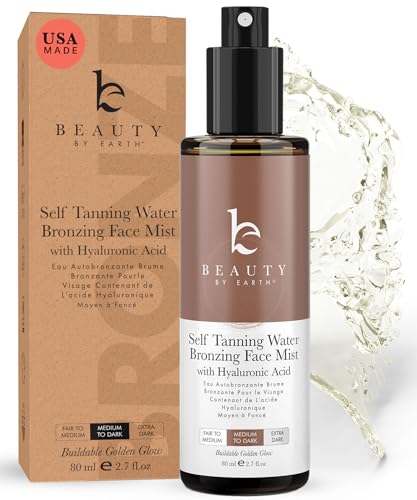
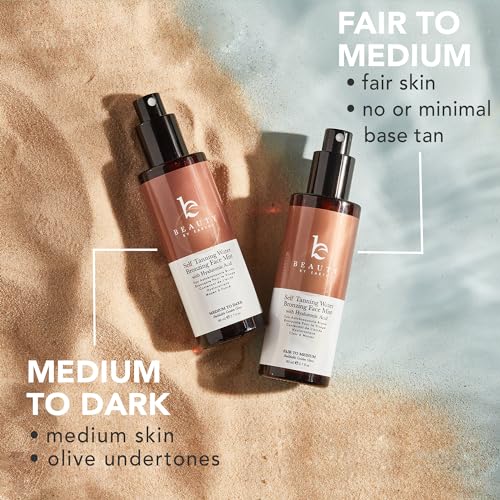
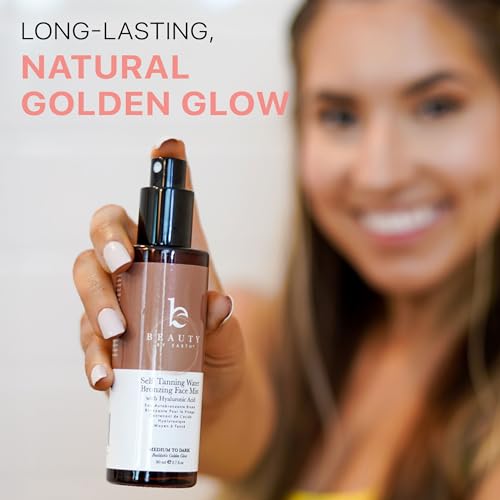
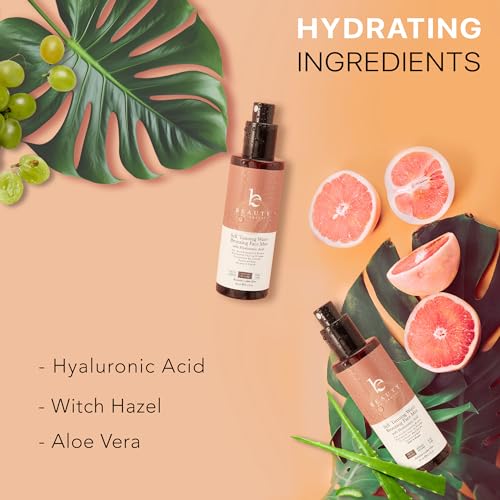
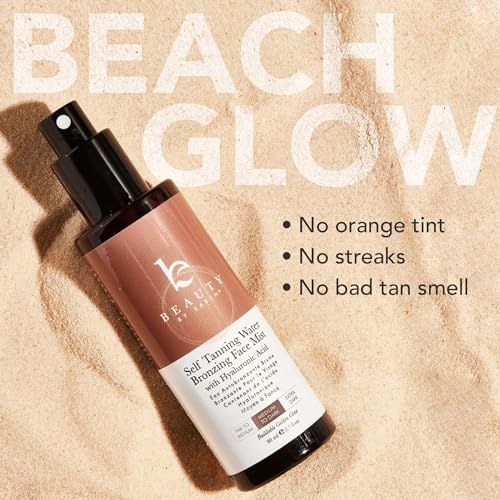
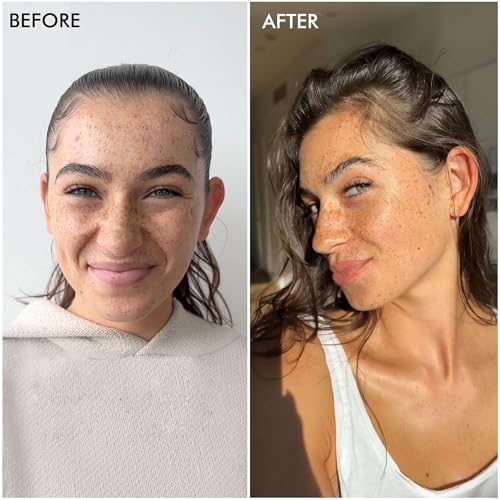
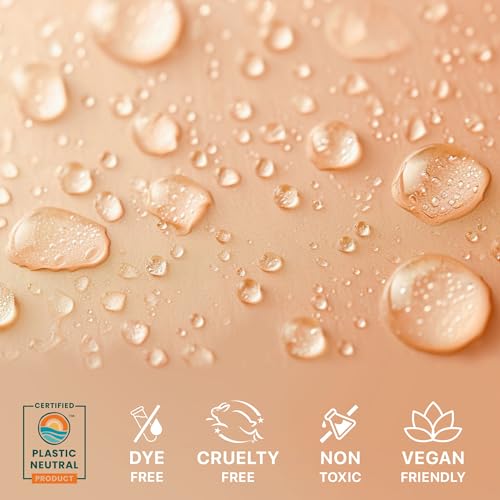
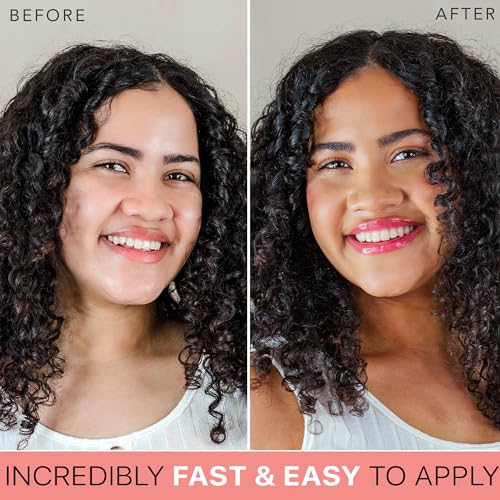
Beauty by Earth Self Tanner - Natural Finish, Organic Ingredients - Face Tanning Mist, 4oz


Lactic Acid
High RiskLactic acid is an alpha hydroxy acid naturally found in milk and fruits. It is commonly used in skincare products for its exfoliating properties, promoting skin renewal and hydration. It can enhance the absorption of other ingredients and is often utilized in formulations aimed at improving skin texture.
Sustai Insights
Lactic acid offers functional benefits such as effective exfoliation and skin hydration. However, it may pose health risks like skin irritation and enhanced absorption of other ingredients, which can lead to increased sensitivity. Regulatory bodies have set high use restrictions due to these concerns. Environmentally, it is not considered bioaccumulative, but care should be taken in disposal to avoid pollution. Overall, the risk level is assessed as high, and usage should be approached with caution, particularly in sensitive populations. Alternatives like glycolic acid may provide similar benefits with varied safety profiles.
Dihydroxyacetone
High RiskDihydroxyacetone is an aliphatic ketone commonly used as a color additive in cosmetics, particularly in self-tanning products. It reacts with amino acids in the skin to produce a temporary brown color, mimicking a tan without exposure to UV radiation.
Sustai Insights
Dihydroxyacetone offers functional benefits as a skin-tanning agent without UV exposure, making it a safer alternative for achieving a bronzed appearance. However, it carries high use restrictions and is associated with low health risks such as irritation. Environmental concerns include its potential to contribute to pollution, while regulatory bodies may issue warnings regarding its use. Overall, the ingredient presents a high risk, necessitating careful consideration of usage practices and potential alternatives.
Mentha Piperita (Peppermint) Oil
High RiskMentha piperita (peppermint) oil is a volatile oil extracted from the leaves of the peppermint plant, known for its strong aroma and flavor. It is commonly used in cosmetics and personal care products for its cooling properties and fragrance enhancement.
Sustai Insights
Peppermint oil offers functional benefits such as antimicrobial properties and a soothing sensation on the skin. However, it is associated with a high potential for allergies and skin irritation. Regulatory bodies impose certain restrictions on its use due to these concerns. The overall risk level is assessed as high, warranting caution in usage, especially for sensitive populations. Alternatives like spearmint oil may provide similar benefits with potentially lower irritation risks.
Rosmarinus Officinalis (Rosemary) Leaf Extract
Medium RiskRosemary leaf extract is produced from the leaves of the Rosmarinus officinalis plant. It is commonly used in cosmetic formulations for its potential antioxidant properties and fragrance. The extract may also contribute to the preservation of products due to its antimicrobial characteristics.
Sustai Insights
Rosemary leaf extract offers functional benefits such as antioxidant and antimicrobial properties, which can enhance product stability and shelf-life. It is generally considered low risk for carcinogenicity and reproductive toxicity, but it carries a moderate potential for allergic reactions. Environmentally, it poses low risk with no significant pollutant or bioaccumulation concerns. Regulatory bodies have not placed significant restrictions on its use, although some verified products cannot contain certain concentrations. Overall, the ingredient's risk level is medium, necessitating careful usage practices to mitigate allergic responses.
Citrus Aurantium Dulcis (Orange) Oil
Medium RiskCitrus aurantium dulcis (orange) oil is a volatile oil extracted from the fresh peel of oranges. It is commonly used in cosmetic and personal care products for its fragrance and potential skin benefits.
Sustai Insights
Citrus aurantium dulcis (orange) oil offers functional benefits as a natural fragrance and may provide skin conditioning effects. However, it has a high allergenic potential, posing risks of skin irritation and allergic reactions. Environmental concerns include moderate persistence and potential bioaccumulation. Regulatory bodies may impose usage restrictions, indicating a medium overall risk level. For safe use, it's advisable to patch test and consider alternatives like other citrus oils or synthetic fragrances to mitigate allergy risks.
Camellia Sinensis (Green Tea) Extract
Medium RiskCamellia sinensis (green tea) extract is derived from the leaves of the Camellia sinensis plant, commonly used in cosmetics and personal care products for its antioxidant properties. It serves as a skin conditioning agent and can provide a soothing effect due to its natural compounds.
Sustai Insights
Green tea extract offers functional benefits such as antioxidant properties that may protect skin from oxidative stress. However, it poses moderate allergenic potential and should be used cautiously by sensitive individuals. Environmentally, it is considered low risk, with no significant bioaccumulation or pollution concerns. Regulatory bodies have not imposed severe restrictions, but users should maintain safe application practices. Overall, the ingredient presents a medium risk profile due to its potential health and environmental impacts.
Citrus Grandis (Grapefruit) Peel Oil
Medium RiskCitrus grandis (grapefruit) peel oil is a volatile essential oil extracted from the peel of grapefruit. It is commonly used for its aromatic properties and as a flavoring agent in various products such as cosmetics and food. Its composition includes compounds like limonene and citral.
Sustai Insights
Citrus grandis (grapefruit) peel oil offers functional benefits such as fragrance enhancement and potential skin conditioning properties. However, it is associated with a high risk of allergic reactions and may enhance skin absorption of other substances. Regulatory restrictions apply, particularly regarding its use in products containing certain chemicals. Environmental concerns include its potential as a pollutant. Overall, it poses a medium risk, necessitating caution during use, especially for sensitive populations. Alternatives may include oils from less allergenic sources.
Glycerin
Medium RiskGlycerin (also called glycerol) is a naturally occurring compound commonly used in personal care and cosmetic products. It functions as a humectant, attracting moisture to the skin, and is also utilized as a solvent and emollient to enhance product texture and stability.
Sustai Insights
Glycerin is valued for its effective moisturizing properties and biodegradability, making it a widely accepted ingredient in formulations. It poses low health risks, including low concerns for carcinogenicity and allergies. However, moderate use restrictions exist due to regulatory guidelines. While glycerin does not significantly contribute to environmental pollution, its production process should be ethically sourced. Overall, glycerin holds a medium risk level, emphasizing the importance of safe usage practices and considering sustainable alternatives.
Hamamelis Virginiana (Witch Hazel) Extract
Low RiskHamamelis virginiana (witch hazel) extract is derived from the bark and leaves of the witch hazel plant. It is commonly used in cosmetic products for its astringent properties, helping to tighten skin and reduce irritation. The extract is recognized for its soothing effects on the skin.
Sustai Insights
Witch hazel extract provides functional benefits as an astringent, helping to minimize skin irritation and enhance skin appearance. It is generally considered low risk for health concerns, with minimal evidence of carcinogenicity, allergenic potential, or reproductive toxicity. Environmental impact is also low, as it does not significantly contribute to pollution or bioaccumulation. Regulatory bodies have not issued major warnings, supporting its safety for use in cosmetics. For safe usage, it is recommended to avoid contact with eyes and to use in appropriate concentrations. Overall, it is regarded as a low-risk ingredient.
Cucumis Sativus (Cucumber) Fruit Extract
Low RiskCucumis sativus (cucumber) fruit extract is derived from the fruit of the cucumber plant. It is commonly used in cosmetic formulations for its hydrating and soothing properties, often included in products aimed at providing moisture and calming effects to the skin.
Sustai Insights
Cucumis sativus fruit extract offers functional benefits such as hydration and soothing effects on the skin, contributing to the overall efficacy of cosmetic products. It is regarded as low risk with minimal health concerns, including low potential for carcinogenicity, irritation, or allergies. Environmental risks are also low, with no significant pollutant or bioaccumulation concerns. Regulatory bodies do not impose restrictions on its use, supporting its safety in cosmetics. Safe usage practices include ensuring proper formulation concentrations. Overall, this ingredient presents a low risk profile, making it a suitable choice for various cosmetic applications.
Leuconostoc/Radish Root Ferment Filtrate
Low RiskLeuconostoc/radish root ferment filtrate is a natural fermentation product derived from radish roots, commonly used in skincare for its potential preservative properties and skin-conditioning benefits. It functions by harnessing the metabolic activity of Leuconostoc bacteria to provide a source of beneficial compounds.
Sustai Insights
This ingredient offers functional benefits, primarily as a preservative and skin-conditioning agent, while being biodegradable and sustainably sourced. Health risks are generally low, with no significant concerns regarding carcinogenicity or allergies, though contamination concerns exist. Environmentally, it poses minimal risks, categorized as low overall risk based on current scientific consensus. Safe usage practices are advised, and alternatives may include other natural preservatives like tocopherol or rosemary extract.
Calendula Officinalis (Pot Marigold) Flower Extract
Low RiskExtract of the Calendula (Calendula officinalis) flower, commonly known as pot marigold, is utilized in cosmetic formulations for its soothing and anti-inflammatory properties. It is often included in creams, lotions, and ointments to promote skin health and healing.
Sustai Insights
Calendula officinalis flower extract offers functional benefits such as skin soothing and anti-inflammatory effects, making it valuable in topical applications. It is considered low risk for health impacts, with minimal concerns regarding carcinogenicity, allergies, or reproductive toxicity. Environmentally, it presents low pollution potential and is not bioaccumulative. Regulatory bodies have not imposed significant restrictions. Safe usage practices should be followed, and while alternatives exist, this extract is generally regarded as a low-risk option for cosmetic use.
Chamomilla Recutita (Matricaria) Flower Extract
Low RiskChamomilla recutita (Matricaria) flower extract is derived from the flower of the chamomile plant. It is commonly used in cosmetic products for its soothing properties and as an anti-inflammatory agent. This extract is valued for its potential to calm skin irritations and enhance overall skin appearance.
Sustai Insights
Chamomilla recutita (Matricaria) flower extract is recognized for its soothing and anti-inflammatory benefits, making it effective in skincare formulations. It is sustainably sourced and not associated with significant health risks, such as carcinogenicity or allergenic potential, resulting in a low-risk profile. Environmental concerns are minimal as it does not contribute significantly to pollution. Regulatory bodies impose few restrictions on its use, further supporting its safety. However, users should practice standard safety measures, particularly if they have known sensitivities. Overall, it is a low-risk ingredient with favorable attributes.
Vitis Vinifera (Grape) Seed Extract
Low RiskVitis vinifera (grape) seed extract is derived from the seeds of grapes and is commonly used in cosmetic formulations for its antioxidant properties. It functions primarily as a skin-conditioning agent and is known for its potential benefits in skincare products.
Sustai Insights
Grape seed extract is valued for its antioxidant properties, which can help protect the skin from oxidative stress. It is generally regarded as safe with low concerns regarding carcinogenicity, allergies, and reproductive toxicity. Environmentally, it poses minimal risks and is not known to bioaccumulate. Regulatory bodies do not impose significant restrictions on its use. Overall, it is assessed as low risk, making it a suitable choice in cosmetic formulations. Alternatives include other plant extracts with similar benefits, such as green tea extract.
Punica Granatum (Pomegranate) Extract
Low RiskPunica granatum (pomegranate) extract is derived from the fruit of the pomegranate. It is commonly used in cosmetic formulations for its antioxidant properties and is believed to support skin health.
Sustai Insights
Pomegranate extract offers functional benefits such as antioxidant protection and skin conditioning. It is considered low risk regarding health concerns, with minimal potential for carcinogenicity, allergies, and reproductive toxicity. Environmental impact appears low, with no significant pollutant or bioaccumulation potential. Regulatory bodies do not impose restrictions on its use. Safe usage practices should be followed, though no significant alternatives are noted. Overall, the ingredient is assessed as low risk.
Hyaluronic Acid
Low RiskHyaluronic acid is a natural polysaccharide found in connective tissues, skin, and cartilage, primarily serving as a moisture-retaining agent in cosmetic products. Its primary function is to provide hydration and improve skin elasticity, making it a common ingredient in moisturizers and serums.
Sustai Insights
Hyaluronic acid offers significant functional benefits, such as effective hydration and skin plumping, while being biodegradable and generally recognized as safe by regulatory bodies. Health risks are minimal, with low concerns regarding carcinogenicity, allergies, or reproductive toxicity. Environmental risks are also low, as it is not considered a pollutant or bioaccumulative. Regulatory bodies have not issued major advisories against its use, resulting in an overall low-risk assessment. For safe usage, it is recommended to apply in appropriate concentrations. Alternatives include glycerin or aloe vera, which also provide hydration.
Aloe Barbadensis (Aloe Vera) Leaf Juice
Low RiskAloe barbadensis (aloe vera) leaf juice is derived from the succulent aloe vera plant, known for its hydrating and soothing properties. It is commonly used in cosmetic formulations for its moisturizing effects and is often included in products aimed at skin care and healing.
Sustai Insights
Aloe vera leaf juice offers functional benefits as a moisturizer and skin soothing agent, while being sustainably sourced and biodegradable. Health risks are low, with minimal concerns regarding carcinogenicity, allergies, and reproductive toxicity. Environmental impact is also low, with no significant pollutants identified. Regulatory agencies impose few restrictions. Overall, the ingredient poses a low risk, making it a favorable choice in cosmetic formulations.
Rosmarinus Officinalis (Rosemary) Leaf Extract
Medium RiskRosemary leaf extract is produced from the leaves of the Rosmarinus officinalis plant. It is commonly used in cosmetic formulations for its potential antioxidant properties and fragrance. The extract may also contribute to the preservation of products due to its antimicrobial characteristics.
Sustai Insights
Rosemary leaf extract offers functional benefits such as antioxidant and antimicrobial properties, which can enhance product stability and shelf-life. It is generally considered low risk for carcinogenicity and reproductive toxicity, but it carries a moderate potential for allergic reactions. Environmentally, it poses low risk with no significant pollutant or bioaccumulation concerns. Regulatory bodies have not placed significant restrictions on its use, although some verified products cannot contain certain concentrations. Overall, the ingredient's risk level is medium, necessitating careful usage practices to mitigate allergic responses.
Lactic Acid
High RiskLactic acid is an alpha hydroxy acid naturally found in milk and fruits. It is commonly used in skincare products for its exfoliating properties, promoting skin renewal and hydration. It can enhance the absorption of other ingredients and is often utilized in formulations aimed at improving skin texture.
Sustai Insights
Lactic acid offers functional benefits such as effective exfoliation and skin hydration. However, it may pose health risks like skin irritation and enhanced absorption of other ingredients, which can lead to increased sensitivity. Regulatory bodies have set high use restrictions due to these concerns. Environmentally, it is not considered bioaccumulative, but care should be taken in disposal to avoid pollution. Overall, the risk level is assessed as high, and usage should be approached with caution, particularly in sensitive populations. Alternatives like glycolic acid may provide similar benefits with varied safety profiles.
Hamamelis Virginiana (Witch Hazel) Extract
Low RiskHamamelis virginiana (witch hazel) extract is derived from the bark and leaves of the witch hazel plant. It is commonly used in cosmetic products for its astringent properties, helping to tighten skin and reduce irritation. The extract is recognized for its soothing effects on the skin.
Sustai Insights
Witch hazel extract provides functional benefits as an astringent, helping to minimize skin irritation and enhance skin appearance. It is generally considered low risk for health concerns, with minimal evidence of carcinogenicity, allergenic potential, or reproductive toxicity. Environmental impact is also low, as it does not significantly contribute to pollution or bioaccumulation. Regulatory bodies have not issued major warnings, supporting its safety for use in cosmetics. For safe usage, it is recommended to avoid contact with eyes and to use in appropriate concentrations. Overall, it is regarded as a low-risk ingredient.
Citrus Aurantium Dulcis (Orange) Oil
Medium RiskCitrus aurantium dulcis (orange) oil is a volatile oil extracted from the fresh peel of oranges. It is commonly used in cosmetic and personal care products for its fragrance and potential skin benefits.
Sustai Insights
Citrus aurantium dulcis (orange) oil offers functional benefits as a natural fragrance and may provide skin conditioning effects. However, it has a high allergenic potential, posing risks of skin irritation and allergic reactions. Environmental concerns include moderate persistence and potential bioaccumulation. Regulatory bodies may impose usage restrictions, indicating a medium overall risk level. For safe use, it's advisable to patch test and consider alternatives like other citrus oils or synthetic fragrances to mitigate allergy risks.
Cucumis Sativus (Cucumber) Fruit Extract
Low RiskCucumis sativus (cucumber) fruit extract is derived from the fruit of the cucumber plant. It is commonly used in cosmetic formulations for its hydrating and soothing properties, often included in products aimed at providing moisture and calming effects to the skin.
Sustai Insights
Cucumis sativus fruit extract offers functional benefits such as hydration and soothing effects on the skin, contributing to the overall efficacy of cosmetic products. It is regarded as low risk with minimal health concerns, including low potential for carcinogenicity, irritation, or allergies. Environmental risks are also low, with no significant pollutant or bioaccumulation concerns. Regulatory bodies do not impose restrictions on its use, supporting its safety in cosmetics. Safe usage practices include ensuring proper formulation concentrations. Overall, this ingredient presents a low risk profile, making it a suitable choice for various cosmetic applications.
Dihydroxyacetone
High RiskDihydroxyacetone is an aliphatic ketone commonly used as a color additive in cosmetics, particularly in self-tanning products. It reacts with amino acids in the skin to produce a temporary brown color, mimicking a tan without exposure to UV radiation.
Sustai Insights
Dihydroxyacetone offers functional benefits as a skin-tanning agent without UV exposure, making it a safer alternative for achieving a bronzed appearance. However, it carries high use restrictions and is associated with low health risks such as irritation. Environmental concerns include its potential to contribute to pollution, while regulatory bodies may issue warnings regarding its use. Overall, the ingredient presents a high risk, necessitating careful consideration of usage practices and potential alternatives.
Leuconostoc/Radish Root Ferment Filtrate
Low RiskLeuconostoc/radish root ferment filtrate is a natural fermentation product derived from radish roots, commonly used in skincare for its potential preservative properties and skin-conditioning benefits. It functions by harnessing the metabolic activity of Leuconostoc bacteria to provide a source of beneficial compounds.
Sustai Insights
This ingredient offers functional benefits, primarily as a preservative and skin-conditioning agent, while being biodegradable and sustainably sourced. Health risks are generally low, with no significant concerns regarding carcinogenicity or allergies, though contamination concerns exist. Environmentally, it poses minimal risks, categorized as low overall risk based on current scientific consensus. Safe usage practices are advised, and alternatives may include other natural preservatives like tocopherol or rosemary extract.
Mentha Piperita (Peppermint) Oil
High RiskMentha piperita (peppermint) oil is a volatile oil extracted from the leaves of the peppermint plant, known for its strong aroma and flavor. It is commonly used in cosmetics and personal care products for its cooling properties and fragrance enhancement.
Sustai Insights
Peppermint oil offers functional benefits such as antimicrobial properties and a soothing sensation on the skin. However, it is associated with a high potential for allergies and skin irritation. Regulatory bodies impose certain restrictions on its use due to these concerns. The overall risk level is assessed as high, warranting caution in usage, especially for sensitive populations. Alternatives like spearmint oil may provide similar benefits with potentially lower irritation risks.
Calendula Officinalis (Pot Marigold) Flower Extract
Low RiskExtract of the Calendula (Calendula officinalis) flower, commonly known as pot marigold, is utilized in cosmetic formulations for its soothing and anti-inflammatory properties. It is often included in creams, lotions, and ointments to promote skin health and healing.
Sustai Insights
Calendula officinalis flower extract offers functional benefits such as skin soothing and anti-inflammatory effects, making it valuable in topical applications. It is considered low risk for health impacts, with minimal concerns regarding carcinogenicity, allergies, or reproductive toxicity. Environmentally, it presents low pollution potential and is not bioaccumulative. Regulatory bodies have not imposed significant restrictions. Safe usage practices should be followed, and while alternatives exist, this extract is generally regarded as a low-risk option for cosmetic use.
Camellia Sinensis (Green Tea) Extract
Medium RiskCamellia sinensis (green tea) extract is derived from the leaves of the Camellia sinensis plant, commonly used in cosmetics and personal care products for its antioxidant properties. It serves as a skin conditioning agent and can provide a soothing effect due to its natural compounds.
Sustai Insights
Green tea extract offers functional benefits such as antioxidant properties that may protect skin from oxidative stress. However, it poses moderate allergenic potential and should be used cautiously by sensitive individuals. Environmentally, it is considered low risk, with no significant bioaccumulation or pollution concerns. Regulatory bodies have not imposed severe restrictions, but users should maintain safe application practices. Overall, the ingredient presents a medium risk profile due to its potential health and environmental impacts.
Chamomilla Recutita (Matricaria) Flower Extract
Low RiskChamomilla recutita (Matricaria) flower extract is derived from the flower of the chamomile plant. It is commonly used in cosmetic products for its soothing properties and as an anti-inflammatory agent. This extract is valued for its potential to calm skin irritations and enhance overall skin appearance.
Sustai Insights
Chamomilla recutita (Matricaria) flower extract is recognized for its soothing and anti-inflammatory benefits, making it effective in skincare formulations. It is sustainably sourced and not associated with significant health risks, such as carcinogenicity or allergenic potential, resulting in a low-risk profile. Environmental concerns are minimal as it does not contribute significantly to pollution. Regulatory bodies impose few restrictions on its use, further supporting its safety. However, users should practice standard safety measures, particularly if they have known sensitivities. Overall, it is a low-risk ingredient with favorable attributes.
Vitis Vinifera (Grape) Seed Extract
Low RiskVitis vinifera (grape) seed extract is derived from the seeds of grapes and is commonly used in cosmetic formulations for its antioxidant properties. It functions primarily as a skin-conditioning agent and is known for its potential benefits in skincare products.
Sustai Insights
Grape seed extract is valued for its antioxidant properties, which can help protect the skin from oxidative stress. It is generally regarded as safe with low concerns regarding carcinogenicity, allergies, and reproductive toxicity. Environmentally, it poses minimal risks and is not known to bioaccumulate. Regulatory bodies do not impose significant restrictions on its use. Overall, it is assessed as low risk, making it a suitable choice in cosmetic formulations. Alternatives include other plant extracts with similar benefits, such as green tea extract.
Punica Granatum (Pomegranate) Extract
Low RiskPunica granatum (pomegranate) extract is derived from the fruit of the pomegranate. It is commonly used in cosmetic formulations for its antioxidant properties and is believed to support skin health.
Sustai Insights
Pomegranate extract offers functional benefits such as antioxidant protection and skin conditioning. It is considered low risk regarding health concerns, with minimal potential for carcinogenicity, allergies, and reproductive toxicity. Environmental impact appears low, with no significant pollutant or bioaccumulation potential. Regulatory bodies do not impose restrictions on its use. Safe usage practices should be followed, though no significant alternatives are noted. Overall, the ingredient is assessed as low risk.
Citrus Grandis (Grapefruit) Peel Oil
Medium RiskCitrus grandis (grapefruit) peel oil is a volatile essential oil extracted from the peel of grapefruit. It is commonly used for its aromatic properties and as a flavoring agent in various products such as cosmetics and food. Its composition includes compounds like limonene and citral.
Sustai Insights
Citrus grandis (grapefruit) peel oil offers functional benefits such as fragrance enhancement and potential skin conditioning properties. However, it is associated with a high risk of allergic reactions and may enhance skin absorption of other substances. Regulatory restrictions apply, particularly regarding its use in products containing certain chemicals. Environmental concerns include its potential as a pollutant. Overall, it poses a medium risk, necessitating caution during use, especially for sensitive populations. Alternatives may include oils from less allergenic sources.
Hyaluronic Acid
Low RiskHyaluronic acid is a natural polysaccharide found in connective tissues, skin, and cartilage, primarily serving as a moisture-retaining agent in cosmetic products. Its primary function is to provide hydration and improve skin elasticity, making it a common ingredient in moisturizers and serums.
Sustai Insights
Hyaluronic acid offers significant functional benefits, such as effective hydration and skin plumping, while being biodegradable and generally recognized as safe by regulatory bodies. Health risks are minimal, with low concerns regarding carcinogenicity, allergies, or reproductive toxicity. Environmental risks are also low, as it is not considered a pollutant or bioaccumulative. Regulatory bodies have not issued major advisories against its use, resulting in an overall low-risk assessment. For safe usage, it is recommended to apply in appropriate concentrations. Alternatives include glycerin or aloe vera, which also provide hydration.
Glycerin
Medium RiskGlycerin (also called glycerol) is a naturally occurring compound commonly used in personal care and cosmetic products. It functions as a humectant, attracting moisture to the skin, and is also utilized as a solvent and emollient to enhance product texture and stability.
Sustai Insights
Glycerin is valued for its effective moisturizing properties and biodegradability, making it a widely accepted ingredient in formulations. It poses low health risks, including low concerns for carcinogenicity and allergies. However, moderate use restrictions exist due to regulatory guidelines. While glycerin does not significantly contribute to environmental pollution, its production process should be ethically sourced. Overall, glycerin holds a medium risk level, emphasizing the importance of safe usage practices and considering sustainable alternatives.
Aloe Barbadensis (Aloe Vera) Leaf Juice
Low RiskAloe barbadensis (aloe vera) leaf juice is derived from the succulent aloe vera plant, known for its hydrating and soothing properties. It is commonly used in cosmetic formulations for its moisturizing effects and is often included in products aimed at skin care and healing.
Sustai Insights
Aloe vera leaf juice offers functional benefits as a moisturizer and skin soothing agent, while being sustainably sourced and biodegradable. Health risks are low, with minimal concerns regarding carcinogenicity, allergies, and reproductive toxicity. Environmental impact is also low, with no significant pollutants identified. Regulatory agencies impose few restrictions. Overall, the ingredient poses a low risk, making it a favorable choice in cosmetic formulations.
Experience a natural-looking glow with Beauty by Earth Self Tanning Face Mist. Designed for easy application and made with clean, organic ingredients, this sunless tanning spray ensures a radiant tan without the harmful effects of UV exposure.
- Easy Application: Simply spritz and go! This tanning water applies effortlessly like a toner, developing a beautiful, sun-kissed look in just 3-5 hours.
- No Residue: Unlike traditional lotions, this mist leaves no sticky residue, making it perfect for a quick refresh throughout the day.
- Natural Color Options: With shades for all skin tones, avoid the orange tint and achieve a radiant glow tailored to you.
- Organic Ingredients: Formulated with certified organic ingredients, including aloe vera and green tea, this self tanner nourishes while it tans, promoting healthy skin.
- Versatile Use: Ideal for daily use or special occasions, this face mist pairs well with other Beauty by Earth self-tanning products for a complete glow-up.
Feel confident in your skin with a natural tan that reflects your commitment to health and the environment.
Subscribe & Save with Sustai
- Best Price Guarantee: Always enjoy the lowest prices on sustainable home essentials.
- No Surprises: We’ll notify you before shipping. No hidden fees, ever.
- You’re in Charge: Change, pause, or cancel your subscription anytime with ease.
- Eco-Friendly Deliveries: Our grouped shipments mean less packaging and lower emissions.
Join us on a sustainable journey. Special offers for a limited time! Prices and promotions may change.
Recommended Products
Experience a natural-looking glow with Beauty by Earth Self Tanning Face Mist. Designed for easy application and made with clean, organic ingredients, this sunless tanning spray ensures a radiant tan without the harmful effects of UV exposure.
- Easy Application: Simply spritz and go! This tanning water applies effortlessly like a toner, developing a beautiful, sun-kissed look in just 3-5 hours.
- No Residue: Unlike traditional lotions, this mist leaves no sticky residue, making it perfect for a quick refresh throughout the day.
- Natural Color Options: With shades for all skin tones, avoid the orange tint and achieve a radiant glow tailored to you.
- Organic Ingredients: Formulated with certified organic ingredients, including aloe vera and green tea, this self tanner nourishes while it tans, promoting healthy skin.
- Versatile Use: Ideal for daily use or special occasions, this face mist pairs well with other Beauty by Earth self-tanning products for a complete glow-up.
Feel confident in your skin with a natural tan that reflects your commitment to health and the environment.

You can have at most 2 Sustainable Steals products in your cart
Customer Reviews
Customers’ View
Customers appreciate the effectiveness and gentle formulation of the Self Tanner Mist, highlighting its ease of application and natural-looking results. Many users note that the mist delivers an even spray without the mess often associated with traditional tanners, with one customer mentioning it applies like a toner. The incorporation of clean, organic ingredients, such as aloe vera and hyaluronic acid, resonates particularly with health-conscious consumers, with users reporting improved skin glow without breakouts. While some users experienced minor color discrepancies, the overall sentiment is positive, with many expressing satisfaction with the product's performance and longevity. Overall, customers find this self-tanner aligns well with their eco-friendly and health-oriented values.
AI-generated from the text of customer reviewsThis product has no reviews yet.




